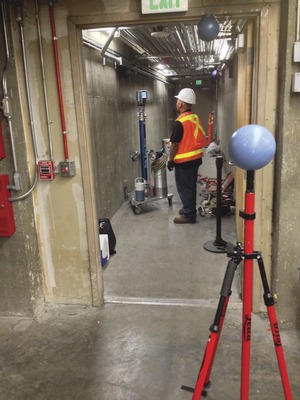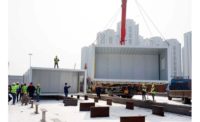

As the construction industry expands the adoption of reality capture, more contractors are using the technology to assess accurately existing conditions, verify work during construction and provide an as-built model of finished work to building owners.
Because developers and manufacturers continue to improve scanning hardware and software, contractors "are able to find a lot more benefits from it, and it's helped us in all of our project types," says David Epps, manager of building information modeling with Holder Construction Group LLC.
Epps joined several other contractors and consultants to present their laser-scanning experiences at ENR's FutureTech conference in San Francisco on March 16-17.
According to a recent Dodge Data & Analytics report, more contractors use laser scanning, but the technology is still in its early stages. Only 13% of contractors are using laser scanning "at a high or very high frequency" to capture existing building conditions into a model before construction, says the report. However, scanning during construction has taken root more quickly, with 23% of contractors using the technology to validate compliance with the model.
Holder recently invested in its own scanning hardware, which the firm uses on projects such as sports stadiums and higher-education facilities. During the coordination cycle on a project for Emory University in Atlanta, Epps scanned a lab area to verify placement of overhead mechanical items, such as fume hoods. The scan data shows subsequent subcontractors any deviations in placement from the design model, and crews can adjust their work accordingly. "It doesn't solve the problem, but it gives us that information ahead of time to where we can proactively approach the problem a little better," he says.
In another case study, Hensel Phelps generated 16 terabytes of data from 240,000 scans for a fast-track chip manufacturing plant in Arizona. The project team designed from the real-time scans, then used the data to guide installation and ensure validation. "We didn't have time to model," says Thai Nguyen, Hensel Phelps' director of virtual design and construction. "We literally had to teach all 23-plus trades how to utilize the native scan content for their designs."
But storing and managing all this data becomes a significant hurdle for contractors. Some even find themselves mailing hard drives due to the massive file sizes and limits to online bandwidth.
"If you implement laser scanning, you need to think about more than just acquiring or adopting the technology," says John M. Russo, president of the U.S. Institute of Building Documentation. "There are a lot of infrastructure upgrades you'll need to be concerned with." Measures include storage and archives, backups and maintenance. "You don't want to throw this data away," he adds.
Scanning could soon be used to track construction during the entire life cycle to provide owners with a real-world model, Epps says. Data would be collected at each stage to capture as-builts of rebar before slab placement or above-ceiling mechanical systems. Then, this data could be embedded into one master model in which a facilities manager could look under floors or above ceilings without ever physically touching anything.
But Russo warns users to be pragmatic in adopting tech, making sure it is "as complex as necessary but as simple as possible. There are a lot of things out there that can get really complicated very quickly."




Post a comment to this article
Report Abusive Comment